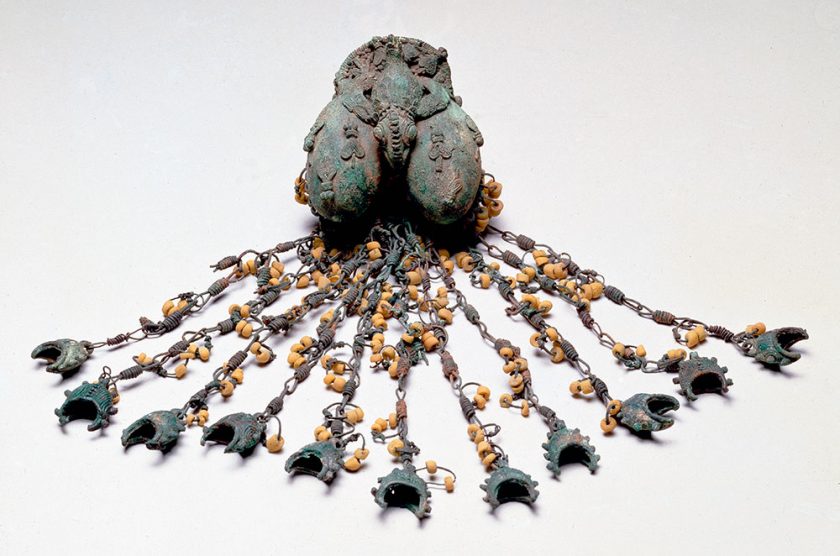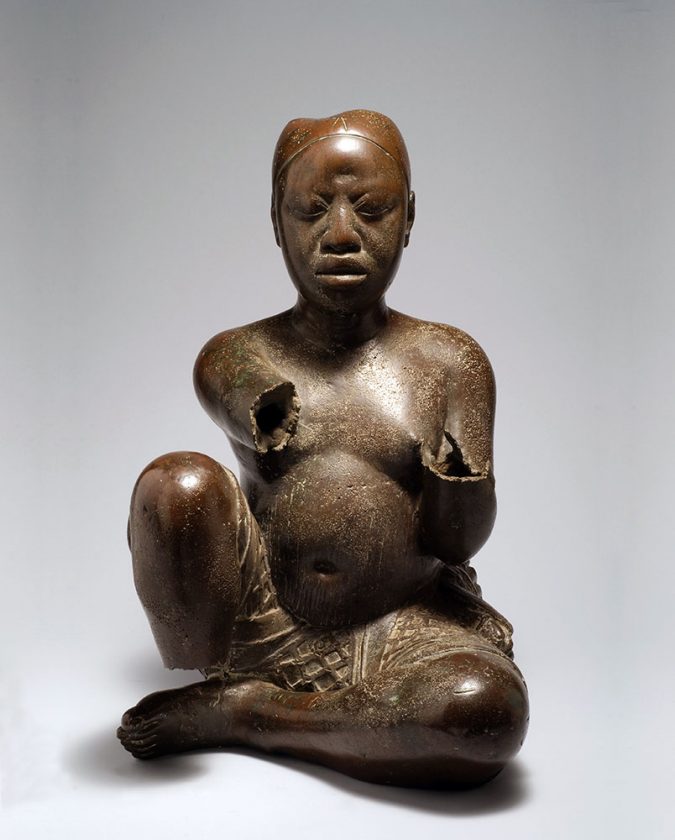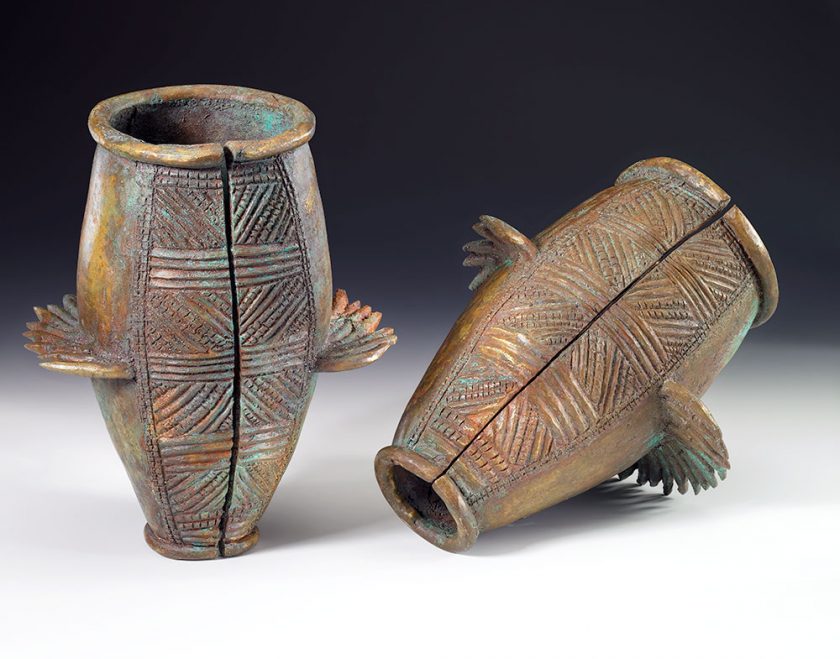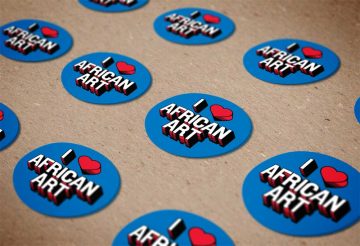
Caravans of Gold home | Saharan Echoes | Driving Desires: Gold and Salt | The Long Reach of the Sahara |
Archaeological Imagination Station: Giving Context to Fragments / Hi Videos | Saharan Frontiers | Shifting Away from the Sahara | Teachers Guide
Subsections: Igbo Ukwu | Ife | Durbi Takusheyi
__________________________
The Niger River descends from . . . Timbuktu then to Ife. Ife is one of the largest countries of the Sudan, and their sultan is one of the greatest sultans.
—Ibn Battuta, 1355 C.E.
“Red Gold” and Global Networks in Africa’s Forests Even kingdoms at the farthest reaches of the Niger River were connected to a global medieval economy. The glorious masterworks of renowned West African forest civilizations, like those at Igbo Ukwu and Ife, demonstrate connections between forest, river, desert, and beyond.
Ibn Battuta, the intrepid 14th-century C.E. Moroccan diplomat, traveler, and writer observed the importance of the Niger River. It led to distant lands of wealth and influence, including the famed kingdom of Ife, in West Africa’s dense rainforest. Like the trading cities and empires of Africa’s Western Sudan, the medieval empires of the forest were deeply entwined in a global economy.
Archaeological excavations at West African sites associated with the Ife kingdom, as well as with the earlier polity of Igbo Ukwu to its southeast, and Durbi Takusheyi to its northeast, reveal the prominence of “red gold,” or copper, as well as glass beads and ivory, among the materials that circulated through the Sahara Desert in multiple directions. Tracing their movement provides a fascinating image of the wide scope of medieval trade.
Igbo Ukwu
8th to early 12th century C.E.
The town of Igbo Ukwu lies east of the Niger River in Nigeria’s forest region. Excavations conducted there unearthed a remarkable group of over 600 prestige objects including extraordinary cast copper alloy sculptures and more than 165,000 glass and carnelian beads.
Evidence ties wealthy and powerful Igbo Ukwu to global medieval trade networks that extended down the Niger River from the edge of the Sahara Desert. Glass beads provide a telling link: the same types have been found at Igbo Ukwu and at Gao (Mali) in the Western Sudan.
At the same time, analyses of cast objects from Igbo Ukwu show its strong ties to local trade. Most of the copper and alloys—primarily tin, lead, and silver—used to make bronze objects there came from nearby sources. This supports the hypothesis that Igbo Ukwu’s innovative metal-casting industry was self-supporting originally. Nonetheless, metal analysis also suggests that the production of copper alloys at Igbo Ukwu may have been supplemented by copper from the Sahara, particularly in the second half of its existence.

Igbo Ukwu, Anambra State, Nigeria
Excavated from Igbo Isaiah (shrine storehouse)
The Roped Pot
8th to early 11th century C.E.
Leaded bronze
National Commission for Museums and Monuments, Abuja, Nigeria, 79.R.4
Twisted Talent | Excavated from a storeroom for ritual objects at Igbo Ukwu, this vessel, known as the Roped Pot, is a masterpiece of lost-wax casting. It was made using a rare technique, called “burning in,” in which separately cast parts are fused together in subsequent firings to achieve a complex form. This unique casting process was certainly developed independently at the site. The copper and silver that make up the bronze alloy came from sources within the region. It is possible that copper was imported to Igbo Ukwu along Saharan trade routes, but only as a supplement to an industry that was sustained locally.

Igbo Ukwu, Anambra State, Nigeria
Excavated from Igbo Isaiah (shrine storehouse)
Pendant of a bird and two eggs
8th to early 11th century C.E.
Leaded bronze, copper wire, glass
National Commission for Museums and Monuments, Abuja, Nigeria, IS.367
Glass in Flight | Many objects found at Igbo Ukwu were decorated with glass beads; this pendant of a bird and two eggs was found alongside yellow beads and copper wires that attached through loops cast along the object’s side. The intricate forms of cast copper alloy objects excavated at Igbo Ukwu attest to the artistry and technological skill of the city’s metal-casting workshops. Surfaces are thickly patterned with raised ropes and dots, evoking strings of glass beads, which were in wide circulation across Africa, Europe, and the Middle East.
Investigator Interview: Beads
Ife13th to 14th century C.E.
Ife, in southern Nigeria, was the political and ritual center of a kingdom that supported a multiethnic regional economy. Its reach extended to the Niger River, nearly 120 miles to its north, paving the way for participation in global networks of exchange. Finds at the village of Tada, on the banks of the Niger, and on Jebba Island suggest that they were strategic outposts for Ife, linking the kingdom to north–south and east–west trade routes.
Workshops at Ife produced a group of sculptural arts in pure copper, copper alloy, and terracotta. The city was also a center for a prolific glass making and glass-bead industry, located in the manufacturing quarter called Igbo Olokun.
Though limited in scope, scientific analysis of the copper and copper alloy sculptures from Ife suggests that some of the ores were mined as far away as France. Active routes of exchange connected Europe with West Africa at this time. Indeed, it is possible that copper, in the form of ingots, was transported along these routes to West African cities far south of the Sahara.

Ife, Osun State, Nigeria
Found at Tada, Kwara State, Nigeria
Seated figure
Late 13th to 14th century C.E.
Copper with traces of arsenic, lead, and tin
National Commission for Museums and Monuments, Abuja, Nigeria, 79.R18.
Masterpiece | The style and the extraordinarily thin casting of this naturalistic figure point to its likely creation at Ife, the royal capital of a powerful kingdom. In the early 20th century C.E. the figure was part of the ritual life of Tada, a small village on the banks of the Niger River 120 miles north of Ife, where it was regularly bathed by local caretakers in the river.
During the medieval period, Tada’s location would have been of strategic importance to Ife, connecting it with long-distance trade. Analysis of the raw copper from which the statue is made suggests that the source metal might have originated in France, traveling along these very trade routes to Ife, where it was cast.

Found at Jebba Island, Kwara State, Nigeria
Bowman
14th to 15th century C.E.
Copper alloy
National Commission for Museums and Monuments, Abuja, Nigeria, 79.R.19
Standing at the Crossroads | This figure of a man wearing woven or quilted armor and carrying a quiver on his back was found on Jebba Island in the Niger River. This is a critical juncture for north–south and east–west trade routes. The figure also wears a large medallion, necklaces, armlets, and anklets strung with cowrie shells. Cowries from the Indian Ocean were used as currency in parts of medieval West Africa. They might have been transported overland to Central Nigeria along east–west routes or across the Sahara and down the Niger River.
14th to 15th century C.E.
Archaeology regularly offers new, remarkable insights into the deep and complex nature of Africa’s globally connected civilizations. Consider, for example, the little-known site of Durbi Takusheyi, in northern Nigeria.
Durbi Takusheyi is situated halfway between the Niger River and Lake Chad, in the heart of the Central Sudan. It provides some of the earliest documentation for the Hausa kingdoms, which would grow to dominate the region between the 16th and the 19th century C.E. Excavations at Durbi Takusheyi included burials with sumptuous grave goods that attest to that kingdom’s global reach.
East of the Niger River’s bend, the Central Sudan extends toward Lake Chad which, though now fast disappearing due to desertification, once supported settled habitation as early as the first millennium B.C.E. As in the Western Sudan, peoples in the Central Sudan engaged in trans-Saharan trade during the medieval period. Routes that passed through the region linked Egypt with the Niger River, supporting an economy that was bolstered by trade in multiple directions.

Durbi Takusheyi, Katsina State, Nigeria
Leglets
Late 14th to15th century C.E.
Copper alloy
National Commission for Museums and Monuments, Abuja, Nigeria, KTM2014.13, KTM2014.1.4
Just for Show | This pair of leglets was cast locally using imported copper. Their size and showy form were a fitting statement of wealth for the individuals with whom they were buried. While these leglets were likely made only to be buried, the vertical slits are functional; they allowed the narrow openings to be expanded so that the anklets could be worn.

Probably made in the Western Sudan
Excavated at Durbi Takusheyi, Katsina State, Nigeria, Tumulus 7
Earrings, pendant, and ring
13th to 15th century C.E.
Gold
National Commission for Museums and Monuments, Abuja, Nigeria, KT2014.1.69a,b, KT2014.1.70, KT2014.1.71
From Opposite Coasts | These four pieces of solid gold jewelry were found among the valuable grave goods of a high-status individual buried at Durbi Takusheyi in north-central Nigeria. They were deposited along with strung cowrie shells in the large Mamluk brass bowl. These extremely rare treasures were acquired through trade in multiple directions. The gold jewelry was likely made in Senegal or southern Mauretania, while the cowrie shells originated in the Indian Ocean and would have traveled along the same routes as the brass bowl.
Greater numbers of ivory tusks from Africa began arriving in northern European harbors around 1230 C.E. due to political shifts that brought Europeans in closer contact with trans-Saharan trade networks. At the same time, copper from Europe made the long trek southward to ivory-rich but copper-hungry economies in Africa’s savanna and forest regions, including Ife.
Tusks of the African savanna elephant, with a diameter sometimes exceeding 4.33 inches, are the largest of any living elephant species. European artists used trial and error to showcase these large pieces of ivory to their fullest advantage.
While carvers at first used the exterior of a tusk for the exterior of a sculpture, as one would with wood, artisans realized over time that the tusk’s interior provided the finest ivory. They aimed to exploit fully this high-quality ivory while avoiding both the hollow pulp cavity in a tusk’s center and the drier material on the exterior.
Ivory was a valued resource in Europe and Africa, controlled by those in power and used for objects of status and prestige. Increased international demand for ivory in recent centuries has endangered elephant populations, however, giving rise to current international bans on its export and use.

France
Virgin and Child
c. 1275–1300 C.E.
Ivory, paint, gold
The Metropolitan Museum of Art, New York, NY, gift of J. Pierpont Morgan, 1917.190.295.
Only African Ivory Sufficed | Large-scale Virgin and Child statuettes represent the apex of ivory carving in the Gothic period in France—and this sculpture is among the largest of its kind. Measuring 6.5 inches in diameter at its widest point, the solid statuette could only have been made from the tusk of an African savanna elephant.
The artist has maximized the size of the figures of the Virgin and Child obtained from the large tusk and has added separate ivory pieces for the throne. This statuette was finished with fine details in paint and gold—another valuable commodity obtained from across the Sahara.

Sicily, Italy
Casket
12th century C.E.
Ivory, brass, tempera, gold leaf
The Art Institute of Chicago, IL, Samuel P. Avery Endowment, 1926.389.
Enduring Glory | This ivory box, or casket, was made in Sicily—long home to a community of Arabic-speaking Muslim peoples. It is economically fashioned from thinly cut pieces of elephant ivory held together with ivory pegs. The presence of a lock and lock plate made of gilded brass, a copper alloy, indicates that the casket’s contents were precious. The delicate ornamental motifs, rendered in tempera and applied gold leaf, are complemented by an inscription in Arabic: “May glory endure.”
Investigator Interview: Ivory


